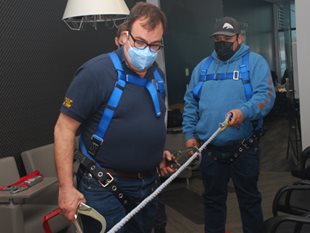 Thursday, April 25, 2024
Thursday, April 25, 2024  Thursday, April 25, 2024
Thursday, April 25, 2024 
A follow-up study looking at the impact of Ontario’s mandated working at heights training confirms standardized training results in safer work.
In fact, lead researcher for this Institute for Work & Health (IWH) study, Dr. Linda Robson says, “Something special is going on in Ontario.” The something special she is referring to is the significant reduction in fall-related injuries suffered by construction workers following the introduction of mandatory and standardized working at heights training. Though, recognizing workers continue to experience falls on construction projects, Dr. Robson suggests “Other approaches to preventing falls from height incidents should continue to be considered too.”
Working at heights (WAH) training standard took effect in 2015 requiring employers ensure workers on construction projects complete standardized and approved WAH training before they work at heights and use fall protection equipment and systems. To remain in compliance, employers must ensure workers they employ complete approved WAH refresher training every three years.
An initial 2019 study of this training standard conducted by the IWH found safe work practice improvements on work sites including purchasing new equipment, more frequent equipment inspections, and checking site for fall hazards. Findings also suggest training led to improved safety knowledge and lower falls from heights-related injury rates.
The soon to be published follow-up study looks at the longer-term impacts of Ontario’s training standard. According to researchers, the findings “Strengthen the initial evaluation methods by adding 2 years of observation and a comparison with other provinces.” The findings were based on surveys of training participants, training providers, employers in the construction sector along with interviews with Ontario Ministry of Labour inspectors. Also reviewed were Workplace Safety and Insurance Board (WSIB) statistics which were then compared to injury rates in other Canadian jurisdictions.